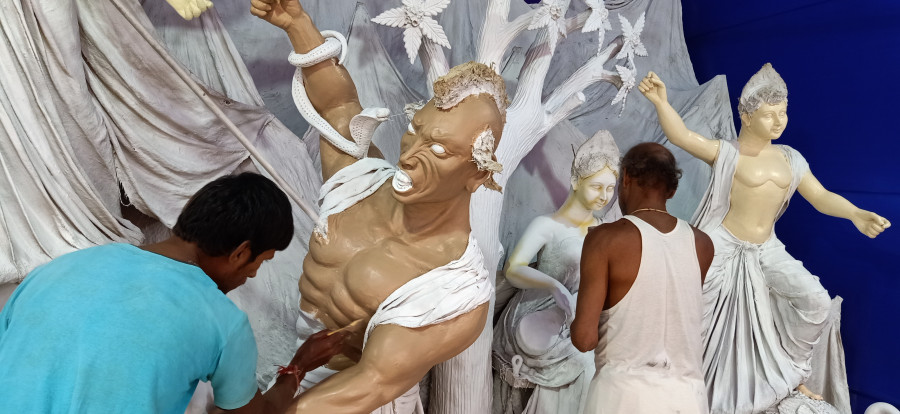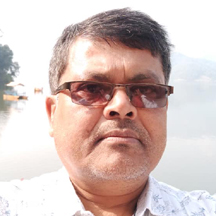Culture & Lifestyle
The communities sculpting a godly living
The arrival of Dashain means it’s high-time for deities fashioned from clay in Mithila region.
Shyam Sundar Shashi
Around 10 sculptors are busy moulding sculptures of goddess Durga inside Jogendra Pandit’s workshop in Bahuwarwa, Janakpur. It’s the onset of Dashain, one of the biggest festivals celebrated in Nepal, so Pandit and his team are busy at work. They have to make and deliver four clay sculptures of the goddess of war to four different places.
Pandit, who learned the art of sculpting gods and goddesses from his father and grandfather, comes from the Kumhar community. Besides the large statues of various gods and goddesses, the community also makes small clay utensils in a style passed down through generations. But in recent years, while some have been leaving the ancestral profession, people from other communities have also started to take up sculpting statues of gods and goddesses.
But in the Mithila region, the tradition of sculpting the statues of gods and goddesses out of clay during various festivals continues to thrive. Even during Dashain, apart from goddess Durga, statues of Ganesh, Saraswati, and Mahisashur are also in demand. Especially in rural areas, it’s common for villagers to place order of statues of different deities for festivals like Krishnastami, Kariya Kumbhari, Bishwakarma Puja, and Saraswati Puja.
The work is labour-intensive, but lucrative. “I charge around Rs85,000 to Rs100,000 to build one statue,” says Pandit. To complete one large statue, four or five artists work for 15-20 days the clay statues are then left to dry for a few days. After which they they are painted. But it takes more than sculpting skills to build these statues, according to Pandit. In addition to the physical and sculptural labour, the workers perform various rituals to appease the gods during various stages of sculpture.
“One needs to have a thorough cultural knowledge of the origin of the gods and goddesses and their Tantrik significance,” says Pandit. “The sculptures should be made following the Dharmashastras.”
Although prevalent in all Hindu societies, the tradition of worshipping statues in Mithila region is carried out to establish a familial relationship with gods and goddesses. Having the statue of goddess Durga made during Dashain also represents a community’s invitation to the goddess into her maternal home.
For the entirety of Dashain, the goddess is offered sweets, a reminiscence of offerings of good food to daughters who visit from their husband’s place. Then, at the end of the nine-day festival, when the statue is taken to a nearby water resource and immersed, Sohar, a special tune sung when daughters leave their maternal home, is chanted to bid farewell until next year.
“Sita is the daughter of Mithila, and Nawadurga along with other goddesses are similar to Sita. That’s why, in the Mithila region, goddesses are still loved as daughters,” says Dr Rajendra Prasad Bimal, formerly of Ramsworup Ramsagar Multiple Campus in Janakpur.
The sculptors, who mostly hail from the same region, understand the cultural significance each statue carries. It is one of the main reasons they are very careful with their art, and carrying out any religious rituals during the statue-making process.
“On the day of Baskatti, which means preparing the bamboo that acts as a foundation for the statues, we worship the bamboo poles with sindoor (red vermilion powder) and pithaar, a mixture of rice flour and water,” says Pandit.
Pandit Rameshwar Jha, who carries out different rituals when the sculptures are being made, says it is imperative proper rituals are observed from the first day until Baskatti, the last day, when the eyes are painted over the statues.
Jha says although all rituals during the making of the statues are important, providing eyes to the statues is an important and sensitive part of the process, which is called ‘upakram’ in the native tongue.
“The main priest has to make kajal by putting together ghee on the leaves of paan, which is then used to draw the eyes on the statues,” says Jha.
In order to successfully accomplish the task, the sculptors are also required to remember and worship their teachers before they start the process, says Pandit. “I also pray to my guru, who happens to be my father Devlal Pandit,” he says.
His sons, however, have left the profession. Pandit is hopeful his 12-year-old grandson, who occasionally helps him with building these statues, will carry on his profession.
But apart from carrying religious and cultural significance, sculptors are making a good living by making these statues. Like Pandit, around 50 sculptors from Dhanusha, Mahottari and Siraha districts are busy building Durga statues this Dashain.




 16.16°C Kathmandu
16.16°C Kathmandu















